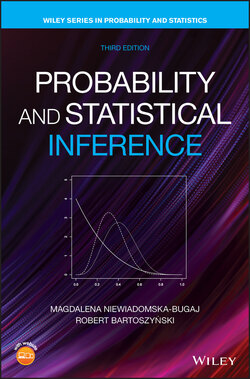Читать книгу Probability and Statistical Inference - Robert Bartoszynski - Страница 93
Problems
Оглавление1 3.3.1 (i) A committee of size 50 is to be formed out of the US Senate at random. Find the probability that each state will be represented. (ii) If a committee of size is to be formed out of the US Senate find how large must be in order for the event “at least one senator from Ohio is included” to be more likely than the event “no senator from Ohio is included.”
2 3.3.2 A shipment of 30 items is received. For the quality control, three items are randomly selected, and if more than one of them is defective then the whole shipment is rejected. Find the probability that the shipment will be accepted if it has: (i) Three defective items (ii) Ten defective items.
3 3.3.3 How many ways can one order the deck of 52 cards so that all four kings are next to each other?
4 3.3.4 Peter lives at the corner of 2nd Avenue and 72nd Street. His office is in the building at a corner of 7th Avenue and 78th Street. The streets and avenues in the city form a perpendicular grid, with no streets or passages in the middle of the blocks. Peter walks to work along either street or avenue, always in the direction that gets him closer to his office. He always returns home by subway, so he walks across town only once a day. (i) How many different paths can Peter choose to go to work? (ii) If Peter makes a list of all possible paths and chooses one of them randomly every morning, how likely it is that he will not walk 4th Avenue between 75th and 76th streets during the next five working days?
5 3.3.5 (Poker Hands) (Poker Hands) Find the probability of each of the following hands: (i) Royal flush (ace, king, queen, jack, and 10 in one suit), (ii) Straight flush (five cards of one suit in a sequence, but not a royal flush), (iii) Flush (five cards in one suit, but not a straight flush nor a royal flush), (iv) Four‐of‐a‐kind (four cards of the same denomination), (v) Full house (one pair and one triple of the same denomination), (vi) Three‐of‐a‐kind (three cards of the same denomination plus two cards unmatched).
6 3.3.6 Find the probability that a poker hand will contain two pairs (one red and the other black) and one unmatched card.
7 3.3.7 A poker player has Q. He discards and Q and obtains 2 cards.3(i) What is the probability that he will have a straight? (ii) Answer the same question if Q is replaced by J (i.e., he discards and J).
8 3.3.8 A poker player has Q. She discards and Q and obtains 2 cards. What is the probability that she will have: (i) A straight flush. (ii) A flush, but not a straight flush. (iii) A straight, but not a straight flush.
9 3.3.9 A poker player has three‐of‐a‐kind. He discards the two unmatched cards and obtains two new cards. Find the probability that he will have: (i) Three‐of‐a‐kind. (ii) Four‐of‐a‐kind. (iii) A full house.
10 3.3.10 (i) If balls are put at random into boxes, find the probability of exactly one box remaining empty? (ii) If balls are randomly placed into boxes (), labeled , find the probability that no box is empty.
11 3.3.11 Compute probabilities of winning numbers in lotteries, where the player chooses: (i) 5 out of 44 numbers. (ii) 6 out of 55 numbers.
12 3.3.12 Find the number of polygonal lines with vertices , where is as in Example 3.12 and with possible edges leading from to or , connecting the points: (i) and . (ii) and . iii) and .
13 3.3.13 Find the number of polygonal lines (as in Problem 3.3.12) that join the points (2,3) and (16, 5) and: (i) Never touch the ‐axis. (ii) Never touch the line = 7.
